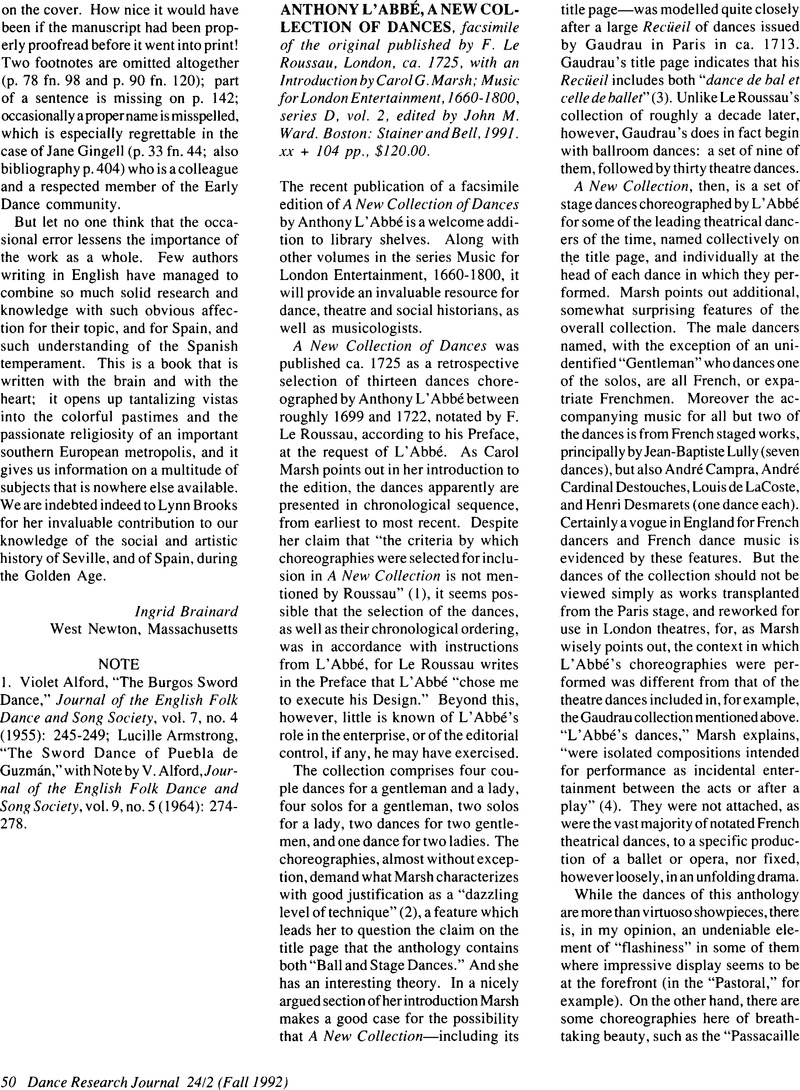No CrossRef data available.
Published online by Cambridge University Press: 22 July 2014

1. Introduction, p. xvi.
2. Introduction, p. xii.
3. The relevant text of this title page is reproduced in Marsh's Introduction, p. xii.
4. Introduction, p. xvii.
5. And elsewhere in the collection, as well: the second to last figure of the “Chacone of Galathee” (p. 29). It was a convention of the noble style, even in theatrical dances, never to assign entrechats six to female dancers. The assymetry between the two dancers created by L'Abbé's observance of this convention is admittedly slight; but it is rendered conspicuous since two of these paired entrechats conclude a figure, and both are followed by two counts of rest.
6. P. x, line 7—read Saraband for “Sarabrand”; p. xi, footnote 19—read D'Angeville for “D'Angevill”; and p. xvii, footnote 34—read have for “bhave”.
7. Schneider, Herbert, Chronologisch thematisches Verzeichnis sämtlicher Werke von Jean-Baptiste Lully (Tutzing: Hans Schneider, 1981)Google Scholar.
8. Evidence of herexpertise in this area will be demonstrated fully in Little, Meredith E. and Marsh, Carol G., La Danse Noble: An Inventory of Sources and Choreographies (New York: Broude Brothers, forthcoming)Google Scholar.
9. Introduction, p. xiv.
10. An Essay towards an History of Dancing (London, 1712)Google Scholar; facsimile ed. in Ralph, Richard, The Life and Works of John Weaver (New York: Dance Horizons, 1985)Google Scholar.
11. Introduction, p. xv.
12. The collection does, however, contain a sequence of three flat steps in a row, not in a character piece but, rather, in “The Pastoral.” The passage occurs in the second figure of the hornpipe section, p. 69.
13. The caption is part of Plate 2 in Marsh's Introduction.
14. I agree that the conclusion of this dance is unusual. In my opinion, however, its most unusual feature is that the dancers are not moving in mirror image to each other but, rather, are moving in the same direction, on the same feet and holding hands.
15. See facsimile edition of this score, vol. 14 of French Opera in the 17th and 18th Centuries, introduced by Fajon, Robert (New York: Pendragon Press, 1984), Act IV, scene ii, pp.. 234–5Google Scholar. Given Marsh's suggested date for the L'Abbé collection, it seems unlikely Le Roussau consulted this source.
16. The three French sources mentioned here share almost identical readings of the tune.
17. Price, Curtis, “Restoration stage fiddlers and their music,” Early Music 7(1979):315–322CrossRefGoogle Scholar; see further his Introduction to Instrumental Music for London Theatres, 1690-1699, MLE A3 (London: Richard MacNutt, 1987)Google Scholar.